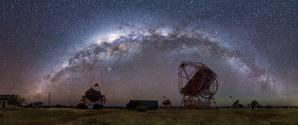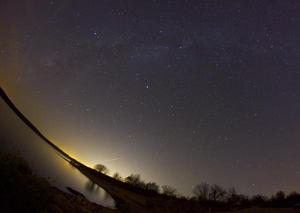Glossary term: खगोलशास्त्र
Description: खगोलशास्त्र हे प्राचीन शास्त्रांपैकी एक आहे आणि त्यात तारे, ग्रह, आकाशगंगा आणि उल्का यांसारख्या आकाशातील खगोलीय वस्तूंचा अभ्यास समाविष्ट आहे. यात पृथ्वी ग्रहाची शेजारच्या ग्रहांशी तुलना करण्यासाठी त्यांच्या वातावरणाचा देखील अभ्यास करतात. पूर्वी, खगोलशास्त्र हे आणि वाहतूक करताना मार्ग शोधण्याच्या (नेव्हिगेशनच्या) उद्देशाने सूर्य, चंद्र आणि ग्रहांच्या स्थानांचा मागोवा घेण्याशी संबंधित होते. आधुनिक खगोलशास्त्रज्ञ आता खगोलीय वस्तूंची निर्मिती आणि वर्तन नियंत्रित करणाऱ्या भौतिक घटनांचाही अभ्यास करतात.
प्राचीन काळी खगोलशास्त्र बहुतेक वेळा छद्म विज्ञान म्हणजे ज्योतिषशास्त्राशी जवळून संबंधित होते आणि बर्याच लोकांना अजूनही या दोघांमधील फरक माहित नाही.
खगोलशास्त्र हे अशा काही विज्ञानांपैकी एक आहे ज्यामध्ये हौशी लोक महत्त्वाची भूमिका बजावू शकतात, कारण हौशी खगोलशास्त्रज्ञांनी अनेक महत्त्वपूर्ण शोधांमध्ये योगदान दिले आहे.
Related Terms:
See this term in other languages
Term and definition status: The original definition of this term in English have been approved by a research astronomer and a teacher The translation of this term and its definition is still awaiting approval
The OAE Multilingual Glossary is a project of the IAU Office of Astronomy for Education (OAE) in collaboration with the IAU Office of Astronomy Outreach (OAO). The terms and definitions were chosen, written and reviewed by a collective effort from the OAE, the OAE Centers and Nodes, the OAE National Astronomy Education Coordinators (NAECs) and other volunteers. You can find a full list of credits here. All glossary terms and their definitions are released under a Creative Commons CC BY-4.0 license and should be credited to "IAU OAE".
If you notice a factual or translation error in this glossary term or definition then please get in touch.
Related Media
The Eclipse Between Us, by Muhammad Rayhan, Indonesia
Credit: Muhammad Rayhan/IAU OAE
License: CC-BY-4.0 Creative Commons Attribution 4.0 International (CC BY 4.0) icons
Chilean observatories at home office, by Robert Barsa, Slovakia
Credit: Robert Barsa/IAU OAE
License: CC-BY-4.0 Creative Commons Attribution 4.0 International (CC BY 4.0) icons
Teide Observatory
Credit: Curd-Christian Tengeler/IAU OAE
License: CC-BY-4.0 Creative Commons Attribution 4.0 International (CC BY 4.0) icons
Learning Nights
Credit: Juan Pablo Botero Londoño/IAU OAE (CC BY 4.0)
License: CC-BY-4.0 Creative Commons Attribution 4.0 International (CC BY 4.0) icons
Milky Way Over H.E.S.S Observatory
Credit: Jianfeng Dai/IAU OAE (CC BY 4.0)
License: CC-BY-4.0 Creative Commons Attribution 4.0 International (CC BY 4.0) icons
Related Activities
Snakes & Ladders Game
astroEDU educational activity (links to astroEDU website) Description: Learn astronomical topics through the classic snakes and ladders game.
License: CC-BY-4.0 Creative Commons Attribution 4.0 International (CC BY 4.0) icons
Tags:
Game
, snakes and Ladders
Age Ranges:
6-8
, 8-10
, 10-12
, 12-14
, 14-16
Education Level:
Middle School
, Primary
, Secondary
Areas of Learning:
Game-mediated learning
Costs:
Medium Cost
Group Size:
Group
Skills:
Asking questions
, Communicating information
AstroPoetry Writing
astroEDU educational activity (links to astroEDU website) Description: An activity combining English and science to encourage students to think about the night sky to help them write a poem related to astronomy.
License: CC-BY-4.0 Creative Commons Attribution 4.0 International (CC BY 4.0) icons
Tags:
Art
, Creativity
, Star-gazing
, Poetry
Age Ranges:
6-8
, 8-10
, 10-12
, 12-14
Education Level:
Middle School
, Primary
, Secondary
Areas of Learning:
Fine Art focussed
, Observation based
Costs:
Low Cost
Duration:
1 hour 30 mins
Group Size:
Individual
Skills:
Communicating information
Create Your Own Astro-Music
astroEDU educational activity (links to astroEDU website) Description: Create your own music inspired by images of space.
License: CC-BY-4.0 Creative Commons Attribution 4.0 International (CC BY 4.0) icons
Tags:
Art
, Creativity
, Music
Age Ranges:
8-10
, 10-12
, 12-14
, 14-16
, 16-19
Education Level:
Informal
, Middle School
, Primary
, Secondary
Areas of Learning:
Fine Art focussed
Costs:
Low Cost
Duration:
1 hour
Group Size:
Group
Skills:
Communicating information
Navigating with the Kamal – Northern Hemisphere
astroEDU educational activity (links to astroEDU website) Description: How did Arabian sailors navigate at sea?
License: CC-BY-4.0 Creative Commons Attribution 4.0 International (CC BY 4.0) icons
Tags:
History
, Geography
, Coordinates
, Celestial navigation
, Arabia
, Kamal
Age Ranges:
14-16
, 16-19
Education Level:
Middle School
, Secondary
Areas of Learning:
Modelling
, Social Research
Costs:
Low Cost
Duration:
1 hour 30 mins
Group Size:
Group
Skills:
Analysing and interpreting data
, Asking questions
, Communicating information
, Developing and using models
, Planning and carrying out investigations
Hunting for spectra
astroEDU educational activity (links to astroEDU website) Description: Learn about light and spectra building a spectroscope with a CD!
License: CC-BY-4.0 Creative Commons Attribution 4.0 International (CC BY 4.0) icons
Tags:
Hands-on
, Experiment
, prism
Age Ranges:
8-10
, 10-12
, 12-14
, 14-16
, 16-19
Education Level:
Informal
, Middle School
, Primary
, Secondary
Areas of Learning:
Guided-discovery learning
Costs:
Low Cost
Duration:
1 hour
Group Size:
Individual
Skills:
Asking questions
, Constructing explanations
, Planning and carrying out investigations


















